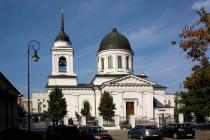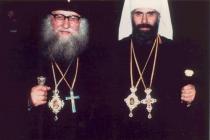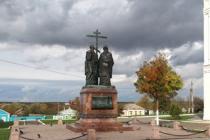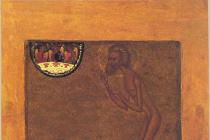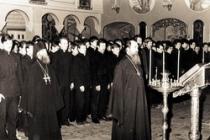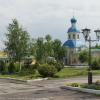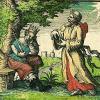Cyril and Methodius, Slavic educators, creators of the Slavic alphabet, preachers of Christianity, the first translators of liturgical books from Greek into Slavic. Cyril (before accepting monasticism at the beginning of 869 - Constantine) (about 827-14.2.869) and his older brother Methodius (about 815-6.4.885) were born in Thessalonica (Thessaloniki) in the family of a military leader. Cyril was educated at the court of the Byzantine Emperor Michael III in Constantinople, where Photius was one of his teachers. He knew Slavic, Greek, Latin, Hebrew and Arabic well. Refusing the admiral career offered to him by the emperor, Kirill became the patriarch's librarian, then taught philosophy (received the nickname "Philosopher"). In the 40s successfully participated in disputes with iconoclasts; in the 50s was in Syria, where he won a victory in theological disputes with Muslims. Around 860 he made a diplomatic trip to the Khazars.
Monument to Saints Equal-to-the-Apostles Cyril and Methodius in Kolomna.
Methodius entered military service early. For 10 years he was the manager of one of the regions inhabited by the Slavs. Then he retired to a monastery. In the 60s, having renounced the rank of archbishop, he became abbot of the Polychron monastery on the Asian shore of the Sea of Marmara.


Monument to Saints Equal-to-the-Apostles Cyril and Methodius in Kolomna.
In 863, Cyril and Methodius were sent by the Byzantine emperor to Moravia in order to preach Christianity in the Slavic language and assist the Moravian prince Rostislav in the fight against the German feudal lords. Before leaving, Cyril created the Slavic alphabet and, with the help of Methodius, translated several liturgical books from Greek into Slavic (selected readings from the Gospel, apostolic epistles, psalter, etc.). There is no consensus in science on the question of which alphabet Kirill created - Glagolitic or Cyrillic (most scientists believe that Glagolitic). The preaching of the brothers in the Slavic language, understandable to the Moravian population, laid the foundation of the national church, but caused discontent among the German Catholic clergy.

Temple of Equal Apostles Cyril and Methodius at Kursk State University.
Cyril and Methodius were accused of heresy. In 866 (or 867), Cyril and Methodius, at the call of Pope Nicholas I, headed to Rome, and along the way they visited the Principality of Blaten (Pannonia), where they also distributed Slavic literacy and Slavic liturgical rites. Pope Adrian II, in a special message, allowed them to distribute Slavic books and Slavic worship. After arriving in Rome, Kirill became seriously ill and died. Methodius was ordained archbishop of Moravia and Pannonia and in 870 returned from Rome to Pannonia. The German clergy, who sought to deal with Methodius, through intrigue, achieved his imprisonment; After his release from prison, Methodius continued his activities in Moravia. In 882-884 he lived in Byzantium. In mid-884, Methodius returned to Moravia and worked on translating the Bible into Slavic.

Monument to Cyril and Methodius in Dmitrov.
With their activities, Cyril and Methodius laid the foundation for Slavic writing and literature. This activity was continued in the South Slavic countries by the students of K. and M., expelled from Moravia in 886.
Life of Saints Equal to the Apostles Cyril and Methodius.
The holy Equal-to-the-Apostles first teachers and Slavic educators, the brothers Cyril and Methodius, came from a noble and pious family that lived in the Greek city of Thessaloniki.
Saint Methodius was the eldest of seven brothers, Saint Constantine (Cyril was his monastic name) the youngest. While in military service, Saint Methodius ruled in one of the Slavic principalities subordinate to the Byzantine Empire, apparently in Bulgarian, which gave him the opportunity to learn the Slavic language. Having lived there for about 10 years, Saint Methodius then became a monk in one of the monasteries on Mount Olympus.
From an early age, Saint Constantine was distinguished by great abilities and studied together with the young Emperor Michael from the best teachers of Constantinople, including Photius, the future Patriarch of Constantinople. Saint Constantine perfectly comprehended all the sciences of his time and many languages; he especially diligently studied the works of Saint Gregory the Theologian, and for his intelligence and outstanding knowledge Saint Constantine received the nickname Philosopher (wise). At the end of his studies, Saint Constantine accepted the rank of priest and was appointed custodian of the Patriarchal Library at the Church of Saint Sophia, but soon left the capital and secretly entered a monastery. Found there and returned to Constantinople, he was appointed teacher of philosophy at the higher school of Constantinople. The wisdom and strength of faith of the still very young Constantine were so great that he managed to defeat the leader of the iconoclast heretics, Annius, in a debate. After this victory, Constantine was sent by the emperor to debate about the Holy Trinity with the Saracens (Muslims) and also won. Having returned, Saint Constantine retired to his brother, Saint Methodius on Olympus, spending time in unceasing prayer and reading the works of the holy fathers.
Soon the emperor summoned both holy brothers from the monastery and sent them to the Khazars to preach the gospel. On the way, they stopped for some time in the city of Korsun, preparing for the sermon. There the holy brothers miraculously found the relics of the Hieromartyr Clement, Pope of Rome (November 25). There, in Korsun, Saint Constantine found the Gospel and the Psalter, written in “Russian letters,” and a man speaking Russian, and began to learn from this man to read and speak his language. After this, the holy brothers went to the Khazars, where they won the debate with Jews and Muslims, preaching the Gospel teaching. On the way home, the brothers again visited Korsun and, taking the relics of Saint Clement there, returned to Constantinople. Saint Constantine remained in the capital, and Saint Methodius received the abbess in the small monastery of Polychron, not far from Mount Olympus, where he had previously labored.
Soon, ambassadors from the Moravian prince Rostislav, oppressed by the German bishops, came to the emperor with a request to send teachers to Moravia who could preach in the native language of the Slavs. The emperor called Saint Constantine and told him: “You need to go there, because no one will do this better than you.” Saint Constantine, with fasting and prayer, began a new feat. With the help of his brother Saint Methodius and the disciples Gorazd, Clement, Savva, Naum and Angelar, he compiled the Slavic alphabet and translated into Slavic the books without which the Divine service could not be performed: the Gospel, the Apostle, the Psalter and selected services. This was in 863.
After completing the translation, the holy brothers went to Moravia, where they were received with great honor, and began to teach Divine services in the Slavic language. This aroused the anger of the German bishops, who performed divine services in Latin in the Moravian churches, and they rebelled against the holy brothers, arguing that divine services could only be performed in one of three languages: Hebrew, Greek or Latin. Saint Constantine answered them: “You recognize only three languages worthy of glorifying God in them. But David cries: Sing to the Lord, all the earth, praise the Lord, all nations, let every breath praise the Lord! And in the Holy Gospel it is said: Go and teach all languages..". The German bishops were disgraced, but became even more embittered and filed a complaint to Rome. The holy brothers were called to Rome to resolve this issue. Taking with them the relics of Saint Clement, Pope of Rome, Saints Constantine and Methodius went to Rome. Having learned that the holy brothers were carrying special holy relics, Pope Adrian and the clergy went out to meet them. The holy brothers were greeted with honor, the Pope approved worship in the Slavic language, and ordered the books translated by the brothers to be placed in Roman churches and the liturgy to be performed in the Slavic language.
While in Rome, Saint Constantine fell ill and, informed by the Lord in a miraculous vision of his approaching death, he took the schema with the name Cyril. 50 days after accepting the schema, on February 14, 869, Equal-to-the-Apostles Cyril died at the age of 42. Going to God, Saint Cyril commanded his brother Saint Methodius to continue their common cause - the enlightenment of the Slavic peoples with the light of the true faith. Saint Methodius begged the Pope to allow his brother's body to be taken away for burial in his native land, but the Pope ordered the relics of Saint Cyril to be placed in the church of Saint Clement, where miracles began to be performed from them.
After the death of Saint Cyril, the pope, following the request of the Slavic prince Kocel, sent Saint Methodius to Pannonia, ordaining him archbishop of Moravia and Pannonia, to the ancient throne of Saint Andronicus the Apostle. In Pannonia, Saint Methodius, together with his disciples, continued to spread divine services, writing and books in the Slavic language. This again angered the German bishops. They achieved the arrest and trial of Saint Methodius, who was exiled to prison in Swabia, where he endured much suffering for two and a half years. Released by order of Pope John VIII and restored to his rights as an archbishop, Methodius continued preaching the gospel among the Slavs and baptized the Czech prince Borivoj and his wife Lyudmila (September 16), as well as one of the Polish princes. For the third time, German bishops launched a persecution against the saint for not accepting the Roman teaching about the procession of the Holy Spirit from the Father and from the Son. Saint Methodius was summoned to Rome, but justified himself before the pope, preserving the purity of the Orthodox teaching, and was again returned to the capital of Moravia - Velehrad.
Here, in the last years of his life, Saint Methodius, with the help of two disciple-priests, translated the entire Old Testament into Slavic, except for the Maccabean books, as well as the Nomocanon (Rules of the Holy Fathers) and the patristic books (Paterikon).
Anticipating the approach of his death, Saint Methodius pointed to one of his disciples, Gorazd, as a worthy successor. The saint predicted the day of his death and died on April 6, 885 at the age of about 60 years. The funeral service for the saint was performed in three languages - Slavic, Greek and Latin; he was buried in the cathedral church of Velehrad.
The memory of one of the most beloved saints by our people - St. Nicholas the Wonderworker, Bishop of Myra in Lycia, is celebrated twice in the church calendar: in winter on December 19 and almost in summer on May 22. Byzantine iconography has preserved many images of St. Nicholas. What did he look like? PHOTO GALLERY.
Despite the fact that the Feast of the Exaltation of the Holy Cross is one of the oldest holidays of the Christian Church, neither the exact time nor the circumstances of its occurrence are reliably known. In the art of Ancient Rus', images of the Exaltation of the Cross were widespread, often included in the festive series of iconostases, while in Byzantium individual icons with a similar plot are not found
The iconography of the most revered saint after the Virgin Mary - John the Baptist - is extensive and complex. The most common icons are the beheading and the discovery of his venerable head
In the Greek text of the Gospel, the apostles are called “fellow disciples.” On July 12, the Church honors the memory of two of them: Peter, the most steadfast of Christ’s disciples, on the cornerstone of his faith the Savior metaphorically promised to build the Church, and Paul, the former persecutor of Palestinian Christians, who believed in the Son of God and converted the Greek world to Christianity.
There are many icon painters in the calendar of the Russian Orthodox Church, but the most famous, of course, is Andrei Rublev. Probably everyone in our country knows this name, even not the most educated person, and outside Russia it is well known, especially after Tarkovsky’s film, but what do we know about the great icon painter? The famous historian of Christian art Irina YAZYKOVA talks about this
August 28 is the last summer holiday: the Dormition of the Blessed Virgin Mary. Holy Scripture is silent about the circumstances of Her death and burial. But the colorful legends recorded in the monuments of church painting have preserved for us the memory of this event. The apostles are miraculously transported on clouds to Jerusalem to behold the Dormition of the Mother of God.
The scene “The Appearance of an Angel to the Myrrh-Bearing Women” is the earliest image of the Resurrection. He was depicted in icons, in mosaics and frescoes, in book miniatures and applied art. Irina YAZYKOVA dismantles the fresco of the dome of the Temple of Pantocrator of the Vysoki Decani monastery in Kosovo
Twelve-year-old Jesus in the temple amazes the teachers of Israel with his knowledge of the Law and wise answers. The youth is depicted sitting on a throne, because He is “in what belongs to the Father.” Irina YAZYKOVA talks about the Icon of the Midsummer from Pskov
Equal to the Apostles mother and son, who established Christianity, Constantine and Helen are saints who are symbolically depicted on icons. What did they really look like? We show both their lifetime images with portrait features and iconographic ones. PHOTO GALLERY
“The Savior Not Made by Hands” by Simon Ushakov: an icon or a portrait of Christ?
On August 29, the Church celebrates the transfer from Edessa to Constantinople of the plate, on which the Face of the Savior was displayed - the Image Not Made by Hands of the Lord Jesus Christ. One of the most amazing icons of the “Savior Not Made by Hands” was painted by the royal icon painter Simon Ushakov in the 17th century. - at a time when icon painting in the church began to give way to realistic painting
On May 6, the Church celebrates the memory of one of the most revered Christian saints - the Great Martyr George the Victorious. His name is associated with many different, sometimes not very consistent, legends. Historical motives, church tradition and folk tales are reflected in the iconography of the saint
On some icons, the Mother of God Herself extends her veil over those praying, on others it is held by angels, and the Virgin prays with people. Different versions of the iconography of the Intercession, starting from the 12th century.
Modern ideas about the work of icon painters increasingly associate the painting of icons with the works of professional craftsmen. The apparent simplicity of some icons did not mean that the master could not write a beautiful, highly artistic work. It was a matter of price. Art critic Zhanna BELIK talks about the cost of icon painting in the second half of the 19th - early 20th centuries and the principles of pricing in icon painting
The fourth Sunday of Great Lent is dedicated to St. John Climacus. Why is the author of the book of the same name, St. John Climacus, depicted without a halo on the “Ladder” icon? Why don’t the demons try their best to drag the monks down, while the angels seem to stay away? Our correspondent tried to understand what was happening with the help of specialists.
An icon is, first of all, a holy image, before which we stand in prayer, a visibly expressed experience of the life of saints. This is also a work of art that conveys to us the idea of our ancestors about beauty. But besides everything else, the icon is also an important historical source that tells about forgotten traditions. What, for example, does the earring in the ear of the Christ Child mean? We remember the unusual details of the icons on the eve of tomorrow's commemoration of the first icon painter - the Apostle and Evangelist Luke.
The first Sunday after Easter is called Fomino Resurrection. Why is it that Thomas, and even nicknamed the Unbeliever, is specifically singled out for the resurrection immediately following the Resurrection of Christ? Not Peter, as the head of the community of apostles, not Andrew, who was called very first, not even John, who was the beloved disciple of Jesus, but Thomas.
In the chapter on the iconostasis, textbooks on the Law of God or OPK usually talk about the high Russian five-tiered iconostasis. But if we go into a temple, we will not always see five rows of icons in front of us, corresponding to the diagram from the book. Why is it that the five-tiered view is chosen to tell the story about the iconostasis?
The federal law “On the transfer of property for religious purposes to religious organizations,” adopted a year and a half ago, became a milestone in property relations between the Church and the state. The next stage of this transfer was the return to the Church of the famous Iveron Icon of the Mother of God in May of this year. Time will tell whether the Church will cope with the “museum” functions, but for now “NS” has followed the fate of the most famous copies of the Iverskaya and other icons of the Mother of God in Russia
On May 24, the Russian Orthodox Church celebrates the memory of Saints Equal-to-the-Apostles Cyril and Methodius.
The name of these saints is known to everyone from school, and it is to them that all of us, native speakers of the Russian language, owe our language, culture, and writing.
Incredibly, all European science and culture were born within the monastery walls: it was in the monasteries that the first schools were opened, children were taught to read and write, and extensive libraries were collected. It was for the enlightenment of peoples, for the translation of the Gospel, that many written languages were created. This happened with the Slavic language.
The holy brothers Cyril and Methodius came from a noble and pious family who lived in the Greek city of Thessaloniki. Methodius was a warrior and ruled the Bulgarian principality of the Byzantine Empire. This gave him the opportunity to learn the Slavic language.
Soon, however, he decided to leave the secular lifestyle and became a monk at the monastery on Mount Olympus. From childhood, Constantine showed amazing abilities and received an excellent education together with the young Emperor Michael 3rd at the royal court.
Then he became a monk in one of the monasteries on Mount Olympus in Asia Minor.
His brother Constantine, who took the name Cyril as a monk, was distinguished by great abilities from an early age and perfectly comprehended all the sciences of his time and many languages.
Soon the emperor sent both brothers to the Khazars to preach the gospel. As the legend says, along the way they stopped in Korsun, where Constantine found the Gospel and the Psalter written in “Russian letters,” and a man speaking Russian, and began to learn to read and speak this language.
When the brothers returned to Constantinople, the emperor again sent them on an educational mission - this time to Moravia. The Moravian prince Rostislav was oppressed by the German bishops, and he asked the emperor to send teachers who could preach in the native language of the Slavs.
The first of the Slavic peoples to turn to Christianity were the Bulgarians. The sister of the Bulgarian prince Bogoris (Boris) was held hostage in Constantinople. She was baptized with the name Theodora and was raised in the spirit of the holy faith. Around 860, she returned to Bulgaria and began to persuade her brother to accept Christianity. Boris was baptized, taking the name Mikhail. Saints Cyril and Methodius were in this country and with their preaching they greatly contributed to the establishment of Christianity in it. From Bulgaria, the Christian faith spread to its neighboring Serbia.
To fulfill the new mission, Constantine and Methodius compiled the Slavic alphabet and translated the main liturgical books (Gospel, Apostle, Psalter) into Slavic. This happened in 863.
In Moravia, the brothers were received with great honor and began to teach Divine services in the Slavic language. This aroused the anger of the German bishops, who performed divine services in Latin in the Moravian churches, and they filed a complaint to Rome.
Taking with them the relics of Saint Clement (Pope), which they discovered back in Korsun, Constantine and Methodius went to Rome.
Having learned that the brothers were carrying holy relics with them, Pope Adrian greeted them with honor and approved the service in the Slavic language. He ordered the books translated by the brothers to be placed in Roman churches and the liturgy to be performed in the Slavic language.
Saint Methodius fulfilled his brother’s will: returning to Moravia already in the rank of archbishop, he worked here for 15 years. From Moravia, Christianity penetrated into Bohemia during the lifetime of Saint Methodius. The Bohemian prince Borivoj received holy baptism from him. His example was followed by his wife Lyudmila (who later became a martyr) and many others. In the mid-10th century, the Polish prince Mieczyslaw married the Bohemian princess Dabrowka, after which he and his subjects accepted the Christian faith.
Subsequently, these Slavic peoples, through the efforts of Latin preachers and German emperors, were torn away from the Greek Church under the rule of the Pope, with the exception of the Serbs and Bulgarians. But all Slavs, despite the centuries that have passed, still have a living memory of the great Equal-to-the-Apostles enlighteners and the Orthodox faith that they tried to plant among them. The sacred memory of Saints Cyril and Methodius serves as a connecting link for all Slavic peoples.
The material was prepared based on information from open sources
At the beginning of the falling away of the Western Church from the Orthodox Universal Church, there was a special desire of the Slavs to accept the Christian faith. The Lord, apparently, called them to complete His Church and raised up for them great preachers of the faith in the person of the Equal-to-the-Apostles brothers Cyril and Methodius.
Cyrus And ll (in the world of Constants And n) and Mef O diy were born in Maked O research in the city of Sol at neither. After completing his education, Methodius entered military service and was the ruler of a Slavic region. Soon, however, he decided to leave the secular lifestyle and became a monk at the monastery on Mount Olympus. From childhood, Constantine expressed amazing abilities and received an excellent education together with the young Emperor Michael 3rd at the royal court, where they were taught by the famous F. O Tiy, later Patriarch Constantine O Polish. After completing his education, Constantine could have had brilliant success in the world, but his heart burned with love for God, and the blessings of the world did not seduce him. For some time he taught his favorite science, philosophy, at the main Constantinople school, but soon left Constantinople and settled in a monastery with his brother Meph O Diem. Here they labored together in fasting and prayer, until the Providence of God called them to preach to the Slavic tribes.
For us Russians, it is worthy of note that before this calling the Lord brought great brothers to be within the borders of our country. In 858, the Khazars, a Caucasian tribe that roamed the southeast of what is now Russia, asked Emperor Michael for preachers of the faith. On behalf of Patriarch Photius, the holy brothers arrived in Kherson. Here they lived for about two years, studying the Khazar language and discovered the relics of the holy martyr Kl. And Mente, Bishop of Rome, exiled here at the end of the first century.
The first of the Slavic peoples to turn to Christianity were the Bulgarians. The sister of the Bulgarian prince Bogoris (Boris) was held hostage in Constantinople. She was baptized with the name Theod O ry and was raised in the spirit of the holy faith. Around 860, she returned to Bulgaria and began to persuade her brother to accept Christianity. Boris was baptized, taking the name Mikhail. Saints Cyril and Methodius were in this country and with their preaching they greatly contributed to the establishment of Christianity in it. From Bulgaria, the Christian faith spread to its neighboring Serbia.
After Bulgaria and Serbia were enlightened, ambassadors from the Moravian prince Rostislav came to Constantinople with the following request: “Our people profess the Christian faith, but we do not have teachers who could explain the faith to us in our native language. Send us such teachers.” The emperor and patriarch rejoiced and, calling the holy Thessalonica brothers, invited them to go to the Moravians. For greater success in preaching, Saint Cyril considered it necessary to translate sacred and liturgical books into Slavic, for “preaching only orally, according to Saint Cyril, is like writing in sand.” But before translation, it was necessary to invent Slavic letters and compose the Slavic alphabet. Saint Cyril, following the example of the apostles, prepared for these great labors with prayer and forty days of fasting. As soon as the alphabet was ready, Saint Cyril translated selected passages from the Gospel and the Apostle into Slavic. Some chroniclers report that the first words written in the Slavic language were the words of the Apostle Evangelist John: “In the beginning was the Word, and the Word was to God, and God was the Word.”
In the year 863, the holy brothers went to Moravia with their disciples Gorazd, Clement, Savva, Naum and others. The performance of divine services and the reading of the Gospel in the Slavic language soon attracted the hearts of the Moravians to them and gave them an advantage over the German preachers. The German and Latin preachers were jealous of these successes and opposed the holy brothers in every possible way. They spread the opinion among the people that the word of God can only be read in three languages in which the inscription on the cross of the Lord was made, namely: Hebrew, Greek and Latin, they called Cyril and Methodius heretics because the holy brothers preached in the Slavic language and finally brought a complaint against them to Pope Nicholas.
The Pope wished to see the Slavic evangelists. Respecting the pope as one of the patriarchs, and hoping to find help from him for their holy cause, the holy brothers went to Rome. They carried with them part of the relics of Equal-to-the-Apostles Clement, Pope of Rome, and the sacred books they translated. Pope Nicholas 1st died without waiting for them. His successor, Pope Adrian, who wanted to pacify the Church, received the holy preachers with great honor. He went out to meet them outside the city, accompanied by the clergy and a multitude of people, received the holy relics from them and reverently placed them in the church of St. Clement, and consecrated the books translated into Slavic on the throne of the most ancient Roman basilica, called Mary Major. Soon after arriving in Rome, Cyril fell dangerously ill. He bequeathed the continuation of the great work to his brother and died peacefully (February 14, 869).
Saint Methodius fulfilled his brother’s will: returning to Moravia already in the rank of archbishop, he worked here for 15 years. From Moravia, Christianity penetrated into Bohemia during the lifetime of Saint Methodius. The Bohemian prince Borivoj received holy baptism from him. His example was followed by his wife Lyudmila (who later became a martyr) and many others. In the mid-10th century, the Polish prince Mieczyslaw married the Bohemian princess Dabrowka, after which he and his subjects accepted the Christian faith.
Subsequently, these Slavic peoples, through the efforts of Latin preachers and German emperors, were torn away from the Greek Church under the rule of the Pope, with the exception of the Serbs and Bulgarians. But all Slavs, despite the centuries that have passed, still have a living memory of the great Equal-to-the-Apostles enlighteners and the Orthodox faith that they tried to plant among them. The sacred memory of Saints Cyril and Methodius serves as a connecting link for all Slavic peoples.
Troparion: I co up O Uniform tables A opinion and words e n countries teaches e Lie, Kir And Lle and Mef O que god at drii, Vlad s ku everyone they say And those, all language s ki words e nsky approved And ty in Pravosl A vii and united at drii, died And you will save the world And our souls.
The siblings Cyril and Methodius came from a pious family that lived in the Greek city of Thessaloniki (in Macedonia). They were the children of the same governor, a Bulgarian Slav. Saint Methodius was the eldest of seven brothers, Saint Constantine (Cyril was his monastic name) the youngest.
Saint Methodius first served, like his father, in a military rank. The Tsar, having learned about him as a good warrior, made him governor of one Slavic principality of Slavinia, which was under the Greek power. This happened at the special discretion of God and so that Methodius could better learn the Slavic language, as the future spiritual teacher and shepherd of the Slavs. Having served in the rank of governor for about 10 years and having experienced the vanity of everyday life, Methodius began to dispose his will to renounce everything earthly and direct his thoughts to the heavenly. Leaving the province and all the pleasures of the world, he became a monk on Mount Olympus.
And his brother Saint Constantine, from his youth, showed brilliant success in both secular and religious-moral education. He studied with the young Emperor Michael from the best teachers in Constantinople, including Photius, the future Patriarch of Constantinople. Having received an excellent education, he perfectly comprehended all the sciences of his time and many languages; he especially diligently studied the works of St. Gregory the Theologian, for which he received the nickname Philosopher (wise). At the end of his studies, Saint Constantine accepted the rank of priest and was appointed keeper of the patriarchal library at the Church of Saint Sophia. But, neglecting all the benefits of his position, he retired to one of the monasteries near the Black Sea. Almost by force, he was returned to Constantinople and appointed a teacher of philosophy at the highest school of Constantinople. The wisdom and strength of faith of the still very young Constantine were so great that he managed to defeat the leader of the iconoclast heretics, Aninius, in a debate.
Then Cyril retired to his brother Methodius and for several years shared monastic exploits with him in a monastery on Olympus, where he first began to study the Slavic language. In the monasteries that were on the mountain, there were many Slavic monks from various neighboring countries, which is why Constantine could have a constant practice here, which was especially important for him, since almost from childhood he spent all his time in the Greek environment. Soon the emperor summoned both holy brothers from the monastery and sent them to the Khazars to preach the gospel. On the way, they stopped for some time in the city of Korsun, preparing for the sermon.
Here the holy brothers learned that the relics of the Hieromartyr Clement, Pope of Rome, were in the sea, and they miraculously found them.
There, in Korsun, Saint Constantine found the Gospel and the Psalter, written in “Russian letters,” and a man speaking Russian, and began to learn from this man to read and speak his language. After this, the holy brothers went to the Khazars, where they won the debate with Jews and Muslims, preaching the Gospel teaching.
Soon, ambassadors from the Moravian prince Rostislav, oppressed by the German bishops, came to the emperor with a request to send teachers to Moravia who could preach in the native language of the Slavs. The emperor called Saint Constantine and told him: “You need to go there, because no one will do this better than you.” Saint Constantine, with fasting and prayer, began a new feat. With the help of his brother Saint Methodius and his disciples Gorazd, Clement, Savva, Naum and Angelar, he compiled the Slavic alphabet and translated into Slavic the books without which the Divine service could not be performed: the Gospel, the Psalter and selected services. Some chroniclers report that the first words written in the Slavic language were the words of the Apostle Evangelist John: “In the beginning was the Word, and the Word was to God, and God was the Word.” This was in 863.
After completing the translation, the holy brothers went to Moravia, where they were received with great honor and began to teach Divine services in the Slavic language. This aroused the anger of the German bishops, who performed divine services in Latin in the Moravian churches, and they rebelled against the holy brothers and filed a complaint to Rome. In 867 St. Methodius and Constantine were summoned by Pope Nicholas I to Rome for trial to resolve this issue. Taking with them the relics of Saint Clement, Pope of Rome, Saints Constantine and Methodius went to Rome. When they arrived in Rome, Nicholas I was no longer alive; his successor Adrian II, having learned that they were carrying with them the relics of St. Clement, met them solemnly outside the city. The Pope approved the Divine Service in the Slavic language, and ordered the books translated by the brothers to be placed in Roman churches and the Liturgy to be celebrated in the Slavic language.
While in Rome, Saint Constantine, informed by the Lord in a miraculous vision of his approaching death, took the schema with the name Cyril. 50 days after accepting the schema, on February 14, 869, Equal-to-the-Apostles Cyril died at the age of 42. Before his death, he told his brother: “You and I, like a friendly pair of oxen, drove the same furrow; I’m exhausted, but don’t think about leaving the work of teaching and retiring to your mountain again.” The Pope ordered the relics of St. Cyril to be placed in the Church of St. Clement, where miracles began to be performed from them.
After the death of Saint Cyril, the pope, following the request of the Slavic prince Kocel, sent Saint Methodius to Pannonia, ordaining him archbishop of Moravia and Pannonia, to the ancient throne of the holy Apostle Antrodin. At the same time, Methodius had to endure a lot of troubles from heterodox missionaries, but he continued the Gospel preaching among the Slavs and baptized the Czech prince Borivoj and his wife Lyudmila (September 16), as well as one of the Polish princes.
In the last years of his life, Saint Methodius, with the help of two disciple-priests, translated the entire Old Testament into Slavic, except for the Maccabean books, as well as the Nomocanon (Rules of the Holy Fathers) and the patristic books (Paterikon).
The saint predicted the day of his death and died on April 6, 885 at the age of about 60 years. The funeral service for the saint was performed in three languages - Slavic, Greek and Latin; he was buried in the cathedral church of Velehrad, the capital of Moravia.
Equal-to-the-Apostles Cyril and Methodius were canonized in ancient times. In the Russian Orthodox Church, the memory of the Equal-to-the-Apostles enlighteners of the Slavs has been honored since the 11th century. The oldest services to saints that have survived to our time date back to the 13th century.
The solemn celebration of the memory of the holy high priests Equal-to-the-Apostles Cyril and Methodius was established in the Russian Church in 1863.
The Iconographic Original for May 11 says: “Our Reverend Fathers Methodius and Constantine, named Cyril, Moravian bishops, Slovenian teachers. Methodius is in the likeness of an old man, with gray hair, wearing the cord of duty like Vlasiev, with the saint’s vestments and omophorion, holding the Gospel in his hands. Constantine - monastic vestments and in the schema, in his hands is a book, and in it is written the Russian alphabet A, B, C, D, D and other words (letters) all in a row...”
By decree of the Holy Synod (1885), the celebration of the memory of Slavic teachers was classified as a middle church holiday. The same decree determined: in prayers at litia, according to the Gospel at matins before the canon, at dismissals, as well as in all prayers in which the ecumenical hierarchs of the Russian Church are remembered, to remember after the name of St. Nicholas, Archbishop of Myra the Wonderworker, the names: like our holy father Methodius and Cyril, Slovenian teachers.
For Orthodox Russia, the celebration of Sts. to the First Teachers has a special meaning: “By them, the Divine Liturgy and all church services began in the language of the Slovenians, which is akin to us, and all church services were performed, and thus an inexhaustible well of water flowing into eternal life was given to us.”


